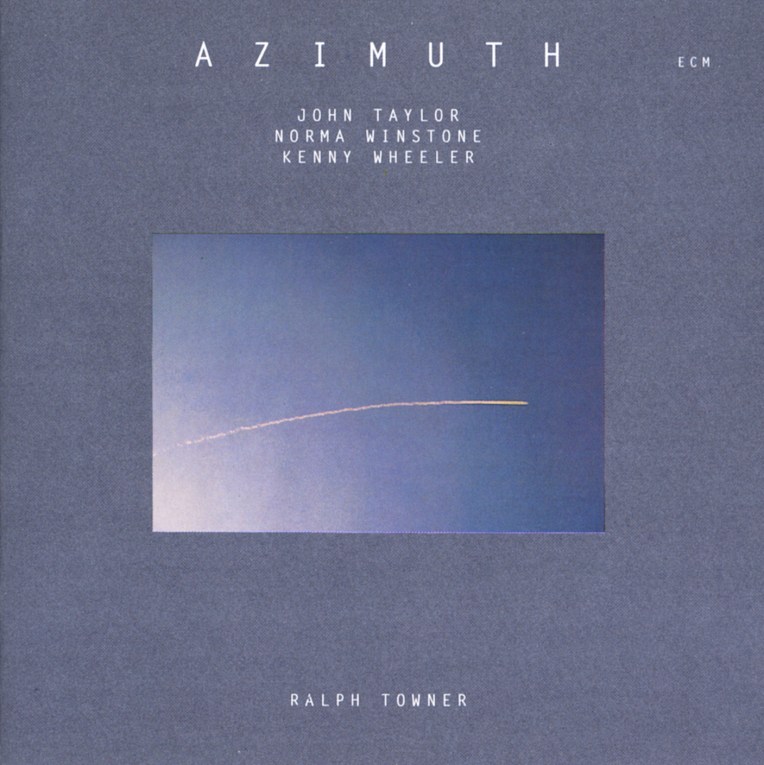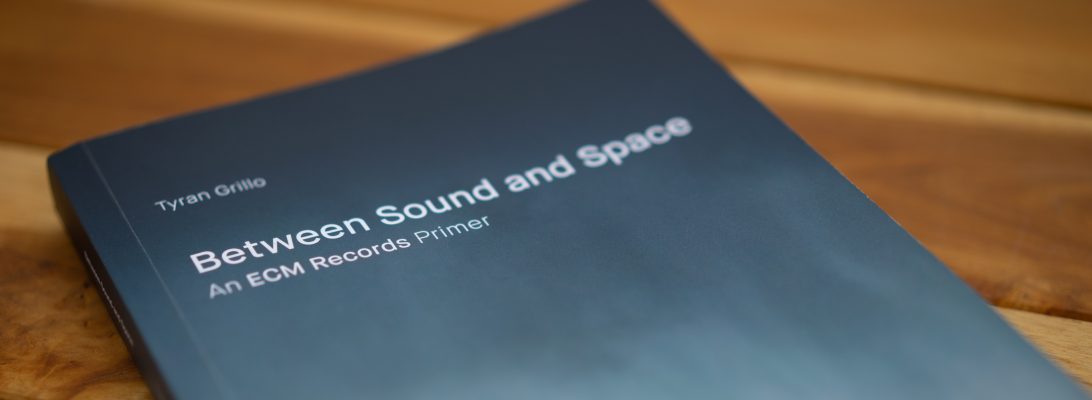
John Taylor piano, organ, synthesizer
Norma Winstone voice
Kenny Wheeler trumpet, fluegelhorn
Ralph Towner 12-string and classical guitars
Azimuth:
1. The arc of the horizon measured clockwise from the south point, in astronomy, or from the north point, in navigation, to the point where a vertical circle through a given heavenly body intersects the horizon.
2. A group made up of vocalist Norma Winstone, husband John Taylor on keyboards, and trumpeter/fluegelhornist Kenny Wheeler whose music, measured from any point, draws an arc through countless heavenly bodies before intersecting with the enchanted listener.
Azimuth was (and remains) emblematic of the ECM label, marking its timelines from 1977 to 2000 with a handful of indelible punctuations. The group’s characteristically expansive sound was overshadowed only by its utter commitment to the melodic line and the trustworthiness of its expression. In the three albums collected for this timely rerelease, the journeys upon which we are taken are the same as those taken by the musicians themselves. Such immediate correspondence is a rare achievement in any vertical circle, and is to be cherished for its productive honesty.

Azimuth (ECM 1099)
Recorded March 1977 at Talent Studio, Oslo
Engineer: Jan Erik Kongshaug
Produced by Manfred Eicher
The group that would become Azimuth began its journey on this self-titled album. “Siren’s Song” rests on the forgiving laurels of a repeated motif, gilded by a horn-flanked voice amid pianistic accents. Like a Steve Reich riff dropped in a pool of jazz, it treats the pulse as the animating force of its creation. Wheeler broadens Winstone’s palette in the melodic relays of “O.” The title track is buoyed by a stunningly gorgeous arpeggiator, over which Winstone sets to flight a pair of overdubbed birds. Once they have flown away, Wheeler draws between their pinpointed forms a sinuous trajectory, along which one is able to chart the album’s path with even more fluid precision. The synthetic backdrop builds in scope, turning what might otherwise be a repetitive New Age loop into an elegiac improvisational exercise. The plaintive piano introduction of “The Tunnel” extends this supportive electricity, into which Winstone begins to sow her potent words. Semantics trail off into further meanderings, reminiscent of the previous track, before the backdrop morphs into a stunning change of key. This makes “Greek Triangle,” a curious piece for brass, all the more whimsical for its appearance. Though outwardly incongruous, it breathes with the same focused spirit that animates the whole, thereby elevating it beyond the status of fanciful diversion. It also serves to refresh our palette for the lyricism of “Jacob,” in which Winstone’s braids and Wheeler’s fluid accents close an altogether fascinating mosaic of atmospheres.
<< Julian Priester and Marine Intrusion: Polarization (ECM 1098)
>> Keith Jarrett: Sun Bear Concerts (ECM 1100)
… . …

The Touchstone (ECM 1130)
Recorded June, 1978 at Talent Studio
Engineer: Jan Erik Kongshaug
Produced by Manfred Eicher
Azimuth’s second ECM effort is also the group’s most enigmatic. The organ that underlies “Eulogy” gives just enough air for Wheeler to glide, and injects all that follows with deep, warm breath. The trio writes a more intimate letter in “Silver,” answered in the unsteady penmanship of “Mayday,” over which our soloists take great care to dot every i and cross every t. The distant muted trumpets of “Jero” mesh with Winstone’s ambulatory menageries. Taylor draws a fluid line through their incantations, ignoring the periphery all the way to the end of “Prelude,” a track so lovely that it makes one want to listen to the album backwards. This is an elusive set, to be sure, filled with quiet, seething power, but also one that builds its nests comfortably over our heads. It can only fly, because it knows no other way to travel.
<< Steve Reich: Music for 18 Musicians (ECM 1129 NS)
>> Pat Metheny: New Chautauqua (ECM 1131)
… . …

Départ (ECM 1163)
Recorded December 1979 at Talent Studios, Oslo
Engineer: Jan Erik Kongshaug
Produced by Manfred Eicher
For its third outing, Azimuth welcomed the strings of guitarist Ralph Towner. “The Longest Day” opens in Solstice territory, setting out through a drizzle of piano and 12-string. Winstone’s overdubs visualize gossamer veils of more distant storms, while Wheeler’s soulful trumpet shines like the sun beyond them. Winstone takes her voice to unexpected heights, pulling a banner of time across the sky into the contemplative piano introduction of “Autumn.” There is no falling. Rather, we get the stillness of those leaves before they die, hanging on with their last vestments of color as the winds arrive to shake them from their boughs. Winstone hangs words in the air amid Towner’s almost pianistic fingerings and Wheeler’s staccato cries. “Arrivée” is just that, but is one of many destinations in this sojourn. Incising solos leave their wounds, closed at last by the plasma of Winstone’s mellifluous protractions. This is followed by a quartet of so-called “Touching Points,” which further extrapolate vocal information from instrumental sources, and vice versa. Wordless fibers are at once spun and frayed in passages of intense physicality. Towner is put to improvisatory task, adding tentative yet appropriate ornaments of his own. The organ drone of the title track respires beneath Winstone’s dips into thermal bliss. Words spread their branches, wrought in tinsel and blown glass. The album ends with a reprise of “The Longest Day” for piano alone. Resplendent and far-reaching, it is a bittersweet ending to Azimuth’s most fully realized effort, through which the project honed its sound to an art.
Azimuth was one of ECM’s most deftly realized acts, and it continues to open like a slow cloudburst every time I immerse myself in it. Its malleable formula provides seemingly endless room for possibility. Winstone’s voice sparkles in the soft focus of consistently sensitive production, a slowly flapping bird with nowhere to go but up. She and Taylor are ideal partners, forging as they do a silent smolder of emotional bonds, while Wheeler heaves his own powerful feathers with conviction. The brief addition of Tower heightens their collective sound, even as it tethers them to the earth. This is a classic set of three seminal albums, each a movement in a larger suite, where souls can dance in motions so slow that they appear as still as ice, and are just as vulnerable to heat.
<< Sam Rivers: Contrasts (ECM 1162)
>> John Abercrombie Quartet: Abercrombie Quartet (ECM 1164)
… . …
<< Bjørnstad/Darling/Rypdal/Christensen: The Sea (ECM 1545)
>> hr-Jazzensemble: Atmospheric Conditions Permitting (ECM 1549/50)


These releases – especially the first two – are very significant to my journey into the ECM collection. They were my first dip into the more abstract releases – to that point, it was Towner, Abercrombie, Jarrett, Metheny and Garbarek. But from the first strains of Siren’s Song, it was clear this was another world entirely – and a wonderful world in which to spend time. Great reviews of some great music.